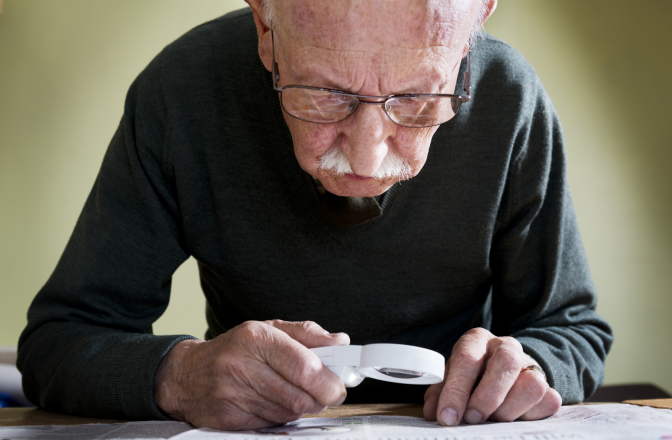Buy One, Get One 50% OFF Eyeglasses
* Restrictions apply. Ask a Team Member for details.
Low Vision Specialists in Kansas

Diagnose Your Vision Problems Today
If you are experiencing visual impairment, and are not able to function well with everyday activities such as reading and driving, you may be suffering from low vision.
Low vision is most often a symptom of a pre-existing eye condition, not a condition on its own. This side-affect is common in individuals suffering from vision problems like macular degeneration, cataracts, diabetic retinopathy, or glaucoma.

Find a The EyeDoctors Optometrists Location Near You
If you are suffering from blurry vision or low vision, it’s not too late to make an appointment and begin your road to recovery. The experts at The EyeDoctors Optometrists can diagnose your low vision issue at any of our Kansas locations.
Vision Rehabilitation Services
Once a low vision diagnosis is confirmed, the optometrists at The EyeDoctors Optometrists can develop a custom eye care treatment plan that is right for you and your vision rehabilitation needs. Rehabilitating your vision is like physical therapy, but for your eyes.
There are a few steps to a vision rehabilitation program. Your optometrist will evaluate your vision, conduct a few eye examinations to assess your visual acuity, and then create your rehabilitation plan. Your rehabilitation plan might include environmental modification and use of low vision devices.
The providers at The EyeDoctors Optometrists are here for you. The goal of low vision rehabilitation is to help preserve your sight. Low vision rehabilitation will not reverse any damage that has already occurred. However, it can help you keep the sight you have left.
Risk Factors For Low Vision
While anyone can experience low vision, it is most common in adults over age 45 and up. One in 6 people above the age of 45 and one in 4 adults over the age of 75 have low vision.
Low vision can be caused by a variety of eye conditions and eye injuries. For example, diabetes may cause diabetic retinopathy, which increases the risk of developing low vision.
Other common causes of low vision are eye diseases such as macular degeneration, cataracts, and glaucoma.
Macular degeneration is a disorder that affects the retina. Though the cause is largely unknown, primary contributors include age, smoking, and a lack of nutrition.
Learn More About Macular Degeneration
A cataract is when part the lens of the eye is clouded. These can be caused by genetics, long term exposure to UV radiation, and other diseases.
Glaucoma occurs when there is increased pressure in the eye caused by problems with fluid drainage. This causes damage to the optic nerve, which can then cause difficulty with night vision, as well as loss or change in peripheral vision.
Understanding Your Low Vision Treatment Options
Low vision is usually permanent. However, the expert eye care team at The EyeDoctors Optometrists may be able to help you improve your vision or prevent it from getting worse. We understand how necessary your vision is for daily activities.
You should pursue low vision rehabilitation as soon as you experience loss of vision. Choosing the right vision rehabilitation team is essential. Our health care professionals create a safe, friendly environment so that you can focus on getting the care you need without external stressors.
Vision rehabilitation is the standard of care for people suffering from vision loss. Your team of eye care professionals may recommend you use low vision aids, such as telescopes, microscopes, or hand magnifiers. These tools are designed to help you as you go through your day. It is important that you and your optometrist discuss the vision services that are best for you and your unique needs.

Schedule A Low Vision Exam at The EyeDoctors Optometrists
Having trouble with your sight? Worried you may have low vision or an underlying vision condition? Be sure to schedule an exam with our vision care experts.
Frequently Asked Questions About Low Vision
At The EyeDoctors Optometrists our goal is to provide each patient with their best possible vision.
The EyeDoctors Optometrists has many offices with low vision doctors conveniently located across the state of Kansas, including an office near you. Be sure to schedule an eye exam with the closest low vision doctor here or by calling (844) 393-2428.
While low vision can be difficult to adjust to, you can still live a fulfilling life. With advances in technology, there are a lot of visual aids and tools that may help you continue to do the things you love to do, even with low vision. These tools can include:
Text-reading software
Check-writing guides
High-contrast clocks and watches
Talking watches and clocks
Large-print publications
Clocks, phones, and watches with large numbers
Books on DVD/CD/audiocassette
Various smartphone apps
Be sure to discuss low vision aid resources further with your optometrist. They may have a list of accessible services in your area, or equipment you can rent or buy.
It depends, if the underlying condition is diagnosed early, such as diabetic retinopathy or cataracts, it can be prevented entirely or reversed. If low vision is caused by a genetic disease, you may be able to seek vision rehabilitation for it to protect your remaining vision.
It is important to have annual eye exams to stay on top of your ocular health. This way if an issue does arise, your optometrist can treat it quickly.